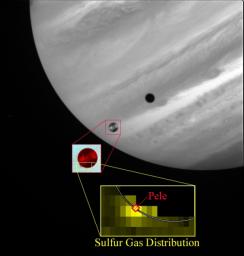
|
Sulfur Gas in Pele’s Plume
- Click the image above for a larger view
- Full-Res JPEG (710 x 746) (42.1 kB)
- Full-Res TIFF (710 x 746) (544.7 kB)
Caption:
This image depicts the discovery of sulfur gas in the plume of the Pele volcano on Jupiter's moon Io, as seen by the Hubble Space Telescope in October 1999, during a flyby of Io by NASA's Galileo spacecraft. The main image shows Io passing in front of Jupiter as seen by Hubble's Wide-Field Planetary Camera (WFPC2) in near-ultraviolet light. The small inset shows that when a WFPC2 image at shorter ultraviolet wavelengths is included in a color composite with the near-ultraviolet image, Io's Pele plume appears as a dark smudge off the edge of Io's disk, silhouetted against Jupiter. The larger inset shows data from Hubble's Space Telescope Imaging Spectrograph, which mapped the composition of Pele's plume by analyzing the ultraviolet light from Jupiter which had passed through the plume. The regions shown in yellow were rich in sulfur gas, which was precisely centered over the Pele volcano, whose position is shown along with the edge of Io's disk.
Background Info:
Additional information about the Hubble Space Telescope is available at http://www.stsci.edu/ . Additional information about the Galileo mission is available at http://solarsystem.nasa.gov/galileo/ .
Cataloging Keywords:
| Name | Value | Additional Values |
|---|---|---|
| Target | Io | Jupiter |
| System | Jupiter | |
| Target Type | Satellite | Planet |
| Mission | Galileo | Hubble Space Telescope (HST) |
| Instrument Host | Galileo Orbiter | Hubble Space Telescope |
| Host Type | Orbiter | Space Telescope |
| Instrument | Photopolarimeter-Radiometer (PPR) | Wide Field/Planetary Camera 2 (WFPC2) |
| Detector | ||
| Extra Keywords | Color, Infrared, Plume, Ultraviolet, Visual, Volcano | |
| Acquisition Date | ||
| Release Date | 2000-05-18 | |
| Date in Caption | ||
| Image Credit | NASA/JPL/Lowell Observatory | |
| Source | photojournal.jpl.nasa.gov/catalog/PIA02546 | |
| Identifier | PIA02546 | |
